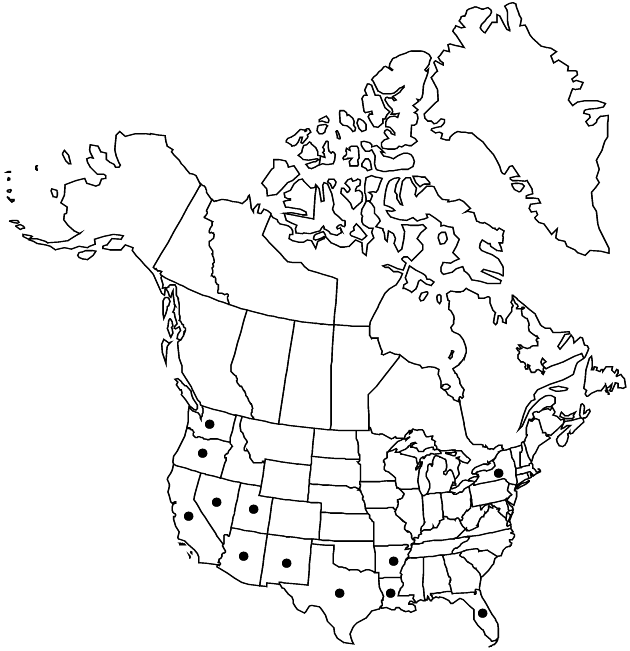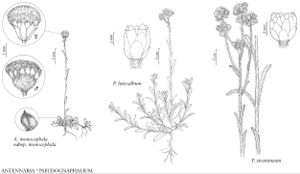Difference between revisions of "Pseudognaphalium luteoalbum"
Bot. J. Linn. Soc. 82: 206. 1981.
FNA>Volume Importer |
imported>Volume Importer |
||
| (2 intermediate revisions by 2 users not shown) | |||
| Line 8: | Line 8: | ||
}} | }} | ||
|common_names=Red-tip rabbit-tobacco | |common_names=Red-tip rabbit-tobacco | ||
| + | |special_status={{Treatment/ID/Special_status | ||
| + | |code=I | ||
| + | |label=Introduced | ||
| + | }}{{Treatment/ID/Special_status | ||
| + | |code=F | ||
| + | |label=Illustrated | ||
| + | }} | ||
|basionyms={{Treatment/ID/Basionym | |basionyms={{Treatment/ID/Basionym | ||
|name=Gnaphalium luteoalbum | |name=Gnaphalium luteoalbum | ||
| Line 30: | Line 37: | ||
|elevation=5–2000 m | |elevation=5–2000 m | ||
|distribution=Ariz.;Ark.;Calif.;Fla.;La.;Nev.;N.Mex.;N.Y.;Oreg.;Tex.;Utah;Wash.;Mexico;Europe;Asia;Africa;Pacific Islands (New Zealand);Australia. | |distribution=Ariz.;Ark.;Calif.;Fla.;La.;Nev.;N.Mex.;N.Y.;Oreg.;Tex.;Utah;Wash.;Mexico;Europe;Asia;Africa;Pacific Islands (New Zealand);Australia. | ||
| + | |introduced=true | ||
|discussion=<p><i>Pseudognaphalium luteoalbum</i> is native to Eurasia. It is similar in overall habit to <i>P. stramineum</i> but distinctive in its larger heads and red-tipped corollas (visible through the translucent phyllaries). Cypselae of <i>P. luteoalbum</i> have papilliform hairs; cypselae of other North American species of <i>Pseudognaphalium</i> are glabrous.</p> | |discussion=<p><i>Pseudognaphalium luteoalbum</i> is native to Eurasia. It is similar in overall habit to <i>P. stramineum</i> but distinctive in its larger heads and red-tipped corollas (visible through the translucent phyllaries). Cypselae of <i>P. luteoalbum</i> have papilliform hairs; cypselae of other North American species of <i>Pseudognaphalium</i> are glabrous.</p> | ||
|tables= | |tables= | ||
| Line 53: | Line 61: | ||
|publication title=Bot. J. Linn. Soc. | |publication title=Bot. J. Linn. Soc. | ||
|publication year=1981 | |publication year=1981 | ||
| − | |special status= | + | |special status=Introduced;Illustrated |
| − | |source xml=https:// | + | |source xml=https://bitbucket.org/aafc-mbb/fna-data-curation/src/2e0870ddd59836b60bcf96646a41e87ea5a5943a/coarse_grained_fna_xml/V19-20-21/V19_680.xml |
|tribe=Asteraceae tribe Gnaphalieae | |tribe=Asteraceae tribe Gnaphalieae | ||
|genus=Pseudognaphalium | |genus=Pseudognaphalium | ||
Latest revision as of 19:54, 5 November 2020
Annuals, 15–40 cm; taprooted or fibrous-rooted. Stems loosely white-tomentose, not glandular. Leaf blades (crowded, internodes 1–5, sometimes to 10 mm) narrowly obovate to subspatulate, 1–3(–6) cm × 2–8 mm (distal smaller, oblanceolate to narrowly oblong or linear), bases subclasping, usually decurrent 1–2 mm, margins weakly revolute, faces mostly concolor to weakly bicolor, abaxial gray-tomentose, adaxial usually gray-tomentose, sometimes glabrescent, neither glandular. Heads in terminal glomerules (1–2 cm diam.). Involucres broadly campanulate, 3–4 mm. Phyllaries in 3–4 series, silvery gray to yellowish (hyaline), ovate to ovate-oblong, glabrous. Pistillate florets 135–160. Bisexual florets 5–10 (corollas red-tipped). Cypselae not evidently ridged (conspicuously dotted with whitish, papilliform hairs; pappus bristles loosely coherent basally, released in clusters or easily fragmented rings). 2n = 14, 16, 28.
Phenology: Flowering Apr–Oct.
Habitat: Roadsides, fields and pastures, ditches, streambanks, seasonal ponds, gardens, and other disturbed sites
Elevation: 5–2000 m
Distribution

Introduced; Ariz., Ark., Calif., Fla., La., Nev., N.Mex., N.Y., Oreg., Tex., Utah, Wash., Mexico, Europe, Asia, Africa, Pacific Islands (New Zealand), Australia.
Discussion
Pseudognaphalium luteoalbum is native to Eurasia. It is similar in overall habit to P. stramineum but distinctive in its larger heads and red-tipped corollas (visible through the translucent phyllaries). Cypselae of P. luteoalbum have papilliform hairs; cypselae of other North American species of Pseudognaphalium are glabrous.
Selected References
None.
